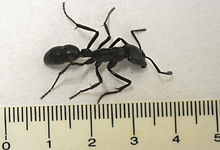Dinoponera quadriceps
| Dinoponera quadriceps | |
|---|---|

| |
| Dinoponera quadriceps | |
| Scientific classification | |
| Domain: | Eukaryota |
| Kingdom: | Animalia |
| Phylum: | Arthropoda |
| Class: | Insecta |
| Order: | Hymenoptera |
| Family: | Formicidae |
| Genus: | Dinoponera |
| Species: | D. quadriceps
|
| Binomial name | |
| Dinoponera quadriceps Kempf, 1971
| |
Dinoponera quadricepsis a queenlessspeciesofantsin thesubfamilyPonerinae.The species, known fromBrazil,is similar toDinoponera muticaand usesvenomfor subduing large live prey and defense. Its venom could be of use to thepharmaceutical industry.
Distribution
[edit]Dinoponera quadricepsis found in theCaatingas,Cerrados,upland humid forest andAtlantic forestin the northeasternBrazilian statesofAlagoas,Bahia,Ceará,Paraíba,PernambucoandRio Grande do Norte.[1]Of allDinoponera,Dinoponera quadricepshas the largest colonies with an average of 80 workers (range 26–238).[2]Dinoponera quadricepsusually nest at the base of trees. Observations ofDinoponera quadricepsnests show that in more aridCaatingaandCerradohabitats, nests are predominantly constructed under trees, whereas inAtlantic forest60% of nests were 3 m away from any tree. Nests are deeper inDinoponera quadriceps(andDinoponera australis) than inDinoponera gigantea,Monninet al.(2003)suggests that deeper nests are a possible adaptation to seasons and aridity.[2]
Description
[edit]Workers of this species is recognized by its finely micro-sculptured integument which is not shiny, rounded anterior inferiorpronotalcorner lacking a tooth-like process, ventral side of the head lacking any gular striations and long/flagellate pilosity.[3]Males are distinguished by the long finesetaeof the second funicular segment, light brown coloration, long narrow parameres, volsella with two small basal teeth and lacking a lobe on the distal edge of digitus volsellaris.[4]
Dinoponera quadricepsmay be confused withDinoponera mutica,but has a finely micro-sculptured integument which is not shiny, lacks gular striations and has apetiolewhich bulges on the dorso-anterior edge in contrast toDinoponera mutica's roughly microsculptured integument, striated gula and petiole with even, non-bulging corners.Dinoponera quadricepsandDinoponera muticadiffer in micro-sculpturing, gular striations and petiole shape. Distribution records show a distance of over 900 km between the two species, but if specimens are found with an integration of characters in the area ofTocantinsand northernGoiasthen these species may need to besynonymized.[5]
Biology
[edit]
Like otherDinoponera,Dinoponera quadricepslacks a distinctqueen casteand all individuals aremorphologicallysimilar and capable of reproduction. InDinoponera quadriceps,dominance hierarchiestend to be relatively short where only a few individuals actively compete for reproduction.[6]Dinoponera quadricepshas a marked seasonal pattern in activity. It is most active in May–August, the late rainy season to early dry season in the semiarid Caatinga. Activity is strongly negatively correlated to temperature and positively correlated to prey abundance. The dietDinoponera quadricepshave been shown to be predominantly scavengedinvertebrates,but include live prey, seeds and fruits. Diet seems to be very similar across the genus, regardless of habitat, and the taxonomic diversity of prey is comparable to other tropical ponerines.[7]
Venom
[edit]For subduing large live prey and defense, workers possess a sting that has been known to cause severe pain lasting up to 48 hours. Due to the high diversity of compounds and systemic effects, venom could be of use to the pharmaceutical industry. For instance,Sousaet al.(2012)demonstrated in mice that venom fromDinoponera quadricepshadantinociceptiveproperties. The authors note that the local population of northeast Brazil uses dry crushedDinoponera quadricepsants to treat earaches, and the stings of live ants are administered for back pain andrheumatism.[8]
References
[edit]- ^Lenhart, Dash & MacKay 2013,p. 151
- ^abLenhart, Dash & MacKay 2013,p. 129
- ^Lenhart, Dash & MacKay 2013,p. 149
- ^Lenhart, Dash & MacKay 2013,p. 150
- ^Lenhart, Dash & MacKay 2013,p. 152
- ^Smithet al.2011,p. 4
- ^Lenhart, Dash & MacKay 2013,pp. 129–130
- ^Lenhart, Dash & MacKay 2013,p. 130
- Lenhart, P.; Dash, S. T.; MacKay, W. P. (2013), "A revision of the giant Amazonian ants of the genus Dinoponera (Hymenoptera, Formicidae)",Journal of Hymenoptera Research,31:119–164,doi:10.3897/JHR.31.4335
- Monnin, T.; Ratnieks, F. L. W.; Brandão, C. R. F. (2003). "Reproductive conflict in animal societies: Hierarchy length increases with colony size in queenless ponerine ants".Behavioral Ecology and Sociobiology.54:71–79.doi:10.1007/s00265-003-0600-9.S2CID11142025.
- Smith, C. R.; Suarez, A. V.; Tsutsui, N. D.; Wittman, S. E.; Edmonds, B.; Freauff, A.; Tillberg, C. V. (2011), Raine, Nigel E (ed.), "Nutritional Asymmetries Are Related to Division of Labor in a Queenless Ant",PLOS ONE,6(8): 1–5,doi:10.1371/journal.pone.0024011,PMC3160331,PMID21886914
- Sousa, P. L.; Quinet, Y. P.; Ponte, E. L.; do Vale, J. F.; Torres, A. F. C.; Pereira, M. G.; Assreuy, A. M. S. (2012)."Venom's antinociceptive property in the primitive antDinoponera quadriceps".Journal of Ethnopharmacology.144(1): 213–216.doi:10.1016/j.jep.2012.08.033.PMID22960549.
 This article incorporates text from a scholarly publication published under a copyright license that allows anyone to reuse, revise, remix and redistribute the materials in any form for any purpose:Lenhart, P.; Dash, S. T.; MacKay, W. P. (2013), "A revision of the giant Amazonian ants of the genus Dinoponera (Hymenoptera, Formicidae)",Journal of Hymenoptera Research,31:119–164,doi:10.3897/JHR.31.4335Please check the source for the exact licensing terms.
This article incorporates text from a scholarly publication published under a copyright license that allows anyone to reuse, revise, remix and redistribute the materials in any form for any purpose:Lenhart, P.; Dash, S. T.; MacKay, W. P. (2013), "A revision of the giant Amazonian ants of the genus Dinoponera (Hymenoptera, Formicidae)",Journal of Hymenoptera Research,31:119–164,doi:10.3897/JHR.31.4335Please check the source for the exact licensing terms. This article incorporates text from a scholarly publication published under a copyright license that allows anyone to reuse, revise, remix and redistribute the materials in any form for any purpose:Smith, C. R.; Suarez, A. V.; Tsutsui, N. D.; Wittman, S. E.; Edmonds, B.; Freauff, A.; Tillberg, C. V. (2011), Raine, Nigel E (ed.), "Nutritional Asymmetries Are Related to Division of Labor in a Queenless Ant",PLOS ONE,6(8): 1–5,doi:10.1371/journal.pone.0024011,PMC3160331,PMID21886914Please check the source for the exact licensing terms.
This article incorporates text from a scholarly publication published under a copyright license that allows anyone to reuse, revise, remix and redistribute the materials in any form for any purpose:Smith, C. R.; Suarez, A. V.; Tsutsui, N. D.; Wittman, S. E.; Edmonds, B.; Freauff, A.; Tillberg, C. V. (2011), Raine, Nigel E (ed.), "Nutritional Asymmetries Are Related to Division of Labor in a Queenless Ant",PLOS ONE,6(8): 1–5,doi:10.1371/journal.pone.0024011,PMC3160331,PMID21886914Please check the source for the exact licensing terms.
External links
[edit] Media related toDinoponera quadricepsat Wikimedia Commons
Media related toDinoponera quadricepsat Wikimedia Commons
